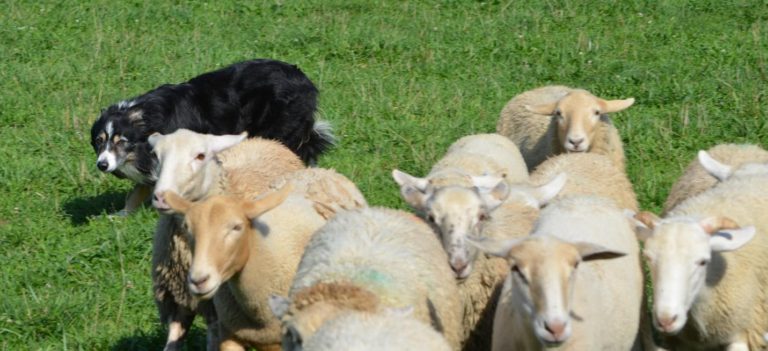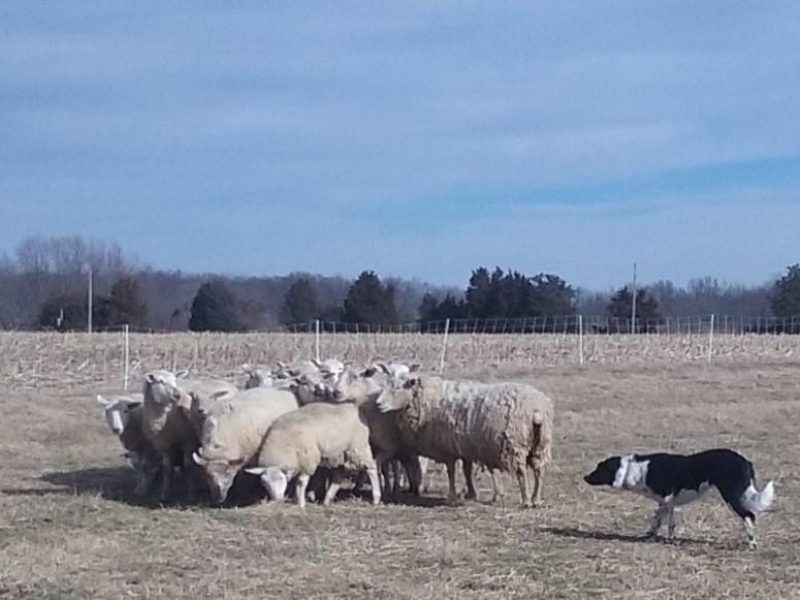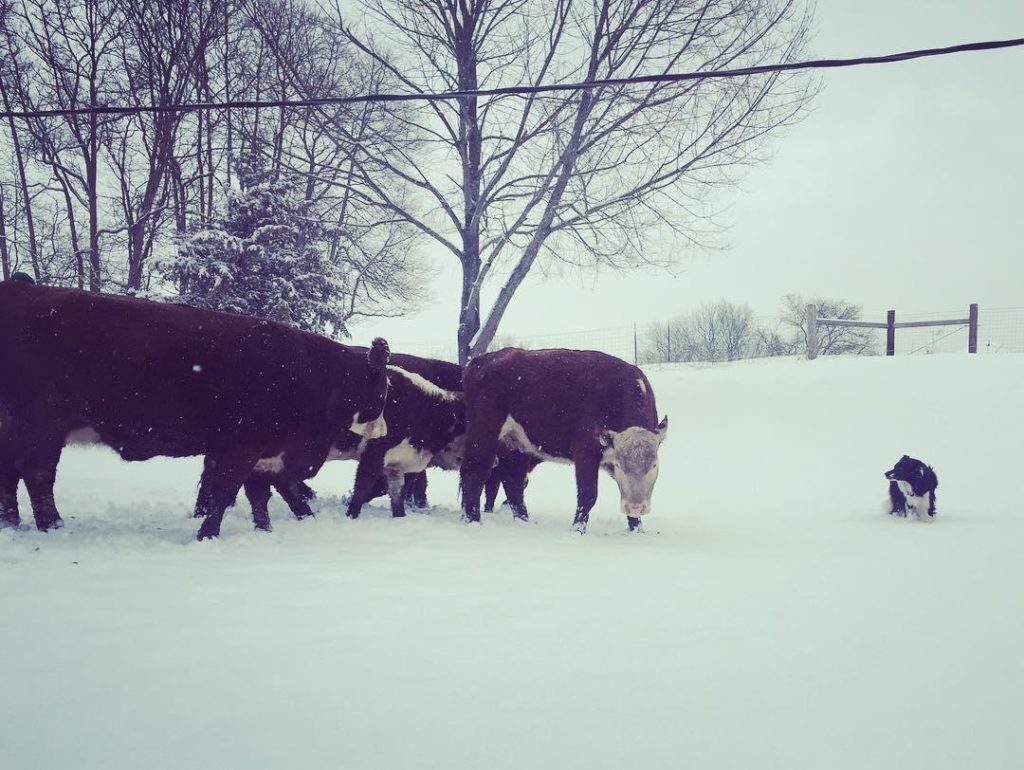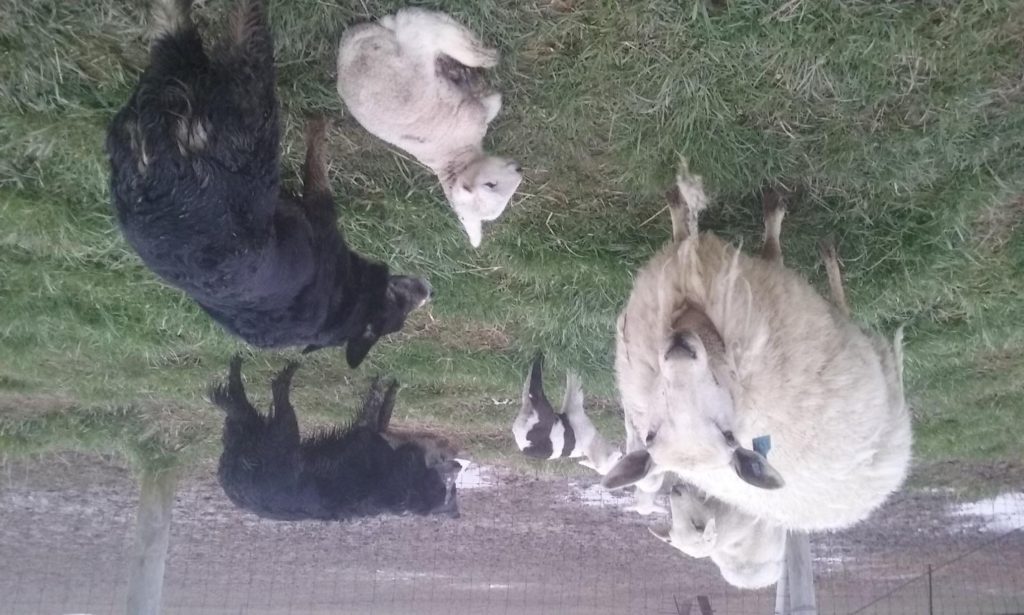By Denice Rackley

SHARE
Stock dogs are like smartphones; they have nearly endless applications. However, to get the most out of smartphones or stock dogs – you need to understand how best to take advantage of their capabilities.
Stock dogs working on livestock operations are used when producers need to gather stock or drive them. (Gather – bring the stock to you. Drive – move the stock away from you.) With a bit of training, both these tasks can be accomplished seamlessly.
A word to ask the dog to begin working, stop, to move toward the stock, and another to call the dog to you is about all that’s needed to complete simple tasks with a dog born with generations of herding instincts passed to him from his working ancestors.
However, if you only ask a herding dog to gather or drive stock, you are just scratching the surface of a dog’s abilities. It’s like buying a smartphone and then only using it to make calls.
It may take you some time to learn how to operate the other features and available apps, but those added capabilities open a world of endless possibilities. If you spend money on a smartphone, it only makes sense to utilize the vast array of options to make life easier.
The same is true for stock dogs.
Endless Capabilities
Stock dogs have endless capabilities. Once you learn to use a stock dog, you can’t imagine how you ever survived without one – just like your smartphone.
Working herding dogs require an investment of time and effort for training for both the dog and handler. Well-bred herding dogs can assist with any task involving livestock.
My dogs assist with:

More Understanding Leads to Wider Use
When I began using a stock dog 21 years ago, I was lucky if my dog Luke gathered my flock of 60 ewes. His idea of a gathering was running straight into a group of sheep.
I knew nothing about stock dogs, much less training them. While I had years of experience with dogs and obedience training, I couldn’t figure out how to teach him to work the stock. If truth be told, I had no idea how it should even look, much less how to communicate to Luke what I needed from him.
Like many others before and after me, I made the big mistake of buying a pup and thinking I could figure it out.
I struggled for five years trying to figure it out. Luke helped every day with my sheep and occasionally with cattle. I kept him close to me when working sheep since I didn’t trust him.
Just his presence improved the stock’s attitude. Livestock became much more respectful and compliant. It was apparent that my dog could be an enormous help if I learned how to use and train him.
It required time, energy, and commitment to learning to work stock dogs. Still, I can’t imagine going back to the days of sheep pushing and shoving, walking out to the pastures to encourage a few stragglers to join the flock, or trying to work stock through a chute alone and needing to be in multiple places at the same time.
With years of working with stock dogs under my belt, raising pups, training them, and helping other producers with their dogs, when I head to the pasture now, I am always accompanied by one of my dogs. There is nothing we encounter that we can’t figure out together.

Good Stock Dogs Require Commitment
It sure didn’t happen overnight. I couldn’t figure out how to break down the training into bite-sized pieces on my own. Reading books and watching videotapes weren’t much help. I couldn’t figure out how all the pieces worked together or how to get from A to B.
The best advice I was given, “Invest in a trained dog with experience to show you what a dog can do. That dog will teach you about stock and how what it takes to use a stock dog for livestock management.”
This is now the advice I give others.
Working with my second dog, Lad, who was well trained and had worked on a large ranch taught me more than any person could. Lad indeed became my mentor.
I studied the stock and dog daily while doing chores. I invested time and money working with clinicians I admired. I practiced and adjusted my techniques as I learned.
Lad made it abundantly clear that I needed to leave my ego at the gate and take notes from him. After all, he was the professional, I was the rank armature.
It was several years working with a trained dog before I put the pieces together. Eventually, I learned how the dog’s positioning and my positioning impacted the stock. I also learned the relationship I have with the dog is critical to us working livestock as a team.
Often, I made things more difficult than they needed to be for both the stock and my dog. With every ‘aahh’ moment, I learned how best to adjust our position to get the job done. It was a good 10 years before I began to feel comfortable training a young dog, knowing I could help the dog mature into a useful partner.
Training requires reading the dog and stock. I learned to look for the places the dog was wrong and work on those pieces. Concentrating on the skills both the dog and I needed to improve, we made progress. Not being afraid of either of us making mistakes or asking for help assisted us in moving forward.
I adjusted my training methods and my thinking. I used to think working stock was about obedience, I was wrong. It is about developing the dog’s natural ability by exposure to stock, helping the dog figure out how his movements impact the stock rather than placing him at a particular spot because I say so.

Right Tool for the Job
I now assist many livestock producers with their stock dogs. I realize how crucial it is to start with a dog that is suited to you, your family, and the tasks that the dog will be asked to accomplish. Beginning with a trained dog will be an initial monetary investment, but you can’t put a price on the lessons you’ll learn from a dog that has been there and done that.
You need the right tool for the job. You wouldn’t hammer in a nail with a screwdriver.
Simply because a dog is a herding breed doesn’t mean it has the instincts and is capable of working livestock or that a particular dog is suited to you or your operation. Each breed has its place. They are all different and all handle livestock very differently.
Using a working dog is far more complicated than it seems. You need to understand what the dog is doing and why it’s moving a certain way. Understanding WHY the dog is positioning itself in a particular place and why the stock are reacting the way they are is essential.
Gaining information and skills to know when working stock is going well but also figure out how to adjust the training when things going south in a hurry is a continual journey.

Before Working Stock
Before taking a young dog to stock, we need to realize everything depends on our relationship with the dog. Trust and respect must be in place. The trick is to understand that obedience is not the same thing as respect.
Trust and respect are a two-way street. We must trust and respect the dog and dogs need to be raised to trust and respect us. Both are built with every interaction.
Training begins day one and success starts outside the pasture gate.
On Stock
The basic skills that come naturally to the dog depend on the individual dog’s instincts and breeding. These skills are molded through initial training. We can easily confuse the dog, making them question their instincts. We need to understand what we are getting into when we have a working bred dog around livestock all day every day. They are smart dogs who crave time with their people. They don’t do well without construction interaction or being left lose to do as they please. Bad habits are easily begun but tough to break.
We need to raise dogs in a way that sets them and us up for success. Most working dogs can’t have access to livestock without us being present without getting into trouble.
It makes no sense to have a working dog and then correct it for wanting to work. We need to be there to direct its thoughts and its feet. Correcting unwanted behavior and rewarding the dog for trying will go a long way in building the needed partnership.
Ability
The dog’s Feel, Balance, and the Contact on livestock dictate how well the dog will work stock. The foundational skills of calling a dog off stock, gathering, and holding stock to you, are needed before you can advance successfully. Attitude and Intent are also key.
Get the building blocks right, the rest will follow.
The same applies to us. We need a good foundation of knowledge. Learn the basics of how stock dogs think, act, and react and how livestock think. Understanding the interaction between the dog and stock and what is needed to control stock enables you to increase your knowledge and skills as you work each day together. You too need to understand feel, balance, flight zones, and how your positioning and attitude impacts stock.
Training or Exposing
I no longer think of ‘training’ a pup. I think of exposing a pup to stock. Encouraging its natural instincts and correcting the mistakes. Mistakes have to do with attitude and intent, not just going the direction I ask.
Many people make the mistake thinking that teaching the dog to respond to a command is what they need for a dog to work. Actually, that is one of the least important parts. If a dog goes right or left when told but is too close to stock, or doesn’t read them correctly, or is simply running in circles, the fact that he goes the direction you asked will not be beneficial. Directional commands are about much more than a direction, they are about feel, balance, intent, and attitude.
Training a stock dog is not about obedience, it’s about building a partnership. This partnership can be a long difficult road. We need mentors along the way to help us – both in the 4-legged and 2-legged form.

Partnerships
If you select the right partner and put in the work, the journey is rewarding. Stock dogs will make you a better person – teaching you patience and perseverance along with a greater understanding and respect for livestock.
If you have gotten the impression that having an excellent stock dog isn’t all sunshine and rainbows, that’s good. Successfully building a seamless partnership is work, even when you communicate in the same language.
Try to communicate in different languages with three different species…
The rewards of putting in the work to figure things out are well worth it. Not only can a dog save you thousands of steps and several hours a day, but they will teach you things about livestock that you never imagined.
Hold onto your hat; you might need to leave your ego outside the pasture gate. Well-bred working dogs are often right, people are the ones that have a steep learning curve when it comes to livestock.
Beside us every step of the way, our dogs cheer us up on tough days and enjoy the good days with us.
Building a relationship with an eager partner that is available 24 hours a day is worth the missteps along the way. You will soon find your stock dog to be more indispensable than your smartphone. These dogs are capable of not only performing a vast array of useful tasks but give us their all.
Stock dogs are far better than smartphones!
If you are interested in learning to use a stock dog on your livestock operation or adding to the skills that you and your dog already have, come join me for a stock dog clinic. There are spring and fall clinics at my place in southeastern Indiana.
Fall Clinic 2022
Jack Knox Clinician
Nov 4 – 6th
Switzerland County Indiana
Each dog/handler team works twice a day, lunch provided.
Cost will be set to cover expenses
Feel free to reach out to me rackleydenice@gmail.com or www.clearfieldstockdogs.com